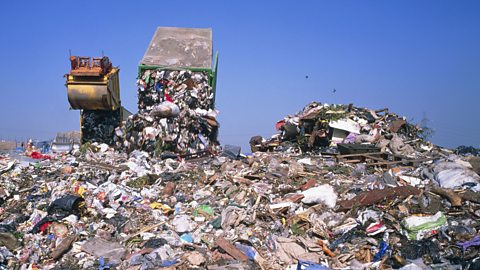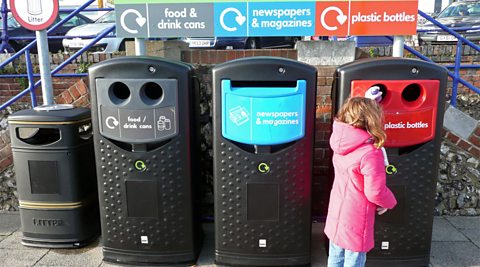Recycling polymers
One of the useful properties of polymerA large molecule formed from many identical smaller molecules known as monomers. is that they are unreactiveA substance is unreactive or inert if it does not easily take part in chemical reactions.. This means they are suitable for storing food and other substances safely. Unfortunately, this property makes it difficult to dispose of polymers.
Most polymers, including poly(ethene) and poly(propene), are not biodegradableMaterial that can be broken down in the environment by microorganisms.. This means that micro organismsMicroscopic living things such as archaea, bacteria and some species of eukaryotes. cannot break them down so they:
- cause a litter problem if disposed of carelessly
- last for many years in landfill sitesPlaces where refuse is buried underground.
Suitable locations for landfill sites are difficult to find. Space in landfill sites is wasted if it is filled with non-biodegradable polymers.

Question
Describe what 'biodegradable' means.
If something is biodegradable, it can be broken down or decomposed by microorganisms.
Incineration
Waste polymers can be incineratedBurned, particularly at a high heat.. This involves combustionThe process of burning by heat. at very high temperatures. Incineration releases a lot of energyThe capacity of a system to do work or the quantity required for mechanical work to take place. Measured in joules (J). For example, a man transfers 100 J of energy when moving a wheelbarrow. which can be used to heat homes or to generate electricity.
There are problems with incineration. Waste gases are produced, including:
- carbon dioxide, a greenhouse gasThe gases responsible for global warming - carbon dioxide, methane, nitrous oxide and CFCs (chlorofluorocarbons). which contributes to global warmingThe rise in the average temperature of the Earth's surface.
- toxicPoisonous. gases, which need removing before they leave the chimney
The use of landfill and incineration wastes valuable resourceAnything that is useful to people. . crude oilMixture of hydrocarbons, mainly alkanes, formed over millions of years from the remains of ancient dead marine organisms. is the raw material for making most polymers, and it is a finite resourceA resource that is no longer being made or which is made extremely slowly, such as crude oil and metal ores..
recyclingReusing materials or reprocessing waste materials to produce new materials. reduces the problems of disposal, and also reduces the volume of crude oil used.

Recycling of PET plastics
PET (polyethylene terephthalate) is a polyester (a plastic). There are two methods to recycle PET:
Open-loop recycling
The flaked PET is not totally pure, so the quality of the recycled material is less than the original polymer. Once the recycled material has been used it cannot be recycled again. It is likely to end up in landfill sites.
Closed-loop recycling
The quality of the recycled material is as high as the original material, so it may be recycled again. This reduces the use of raw material (crude oil) and landfill even more than open-loop recycling.